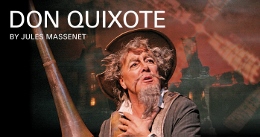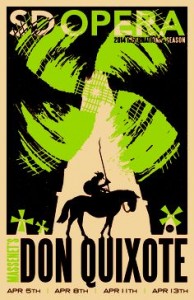SAN DIEGO OPERA’S SWAN SONG SPEAKS TO DREAMING IMPOSSIBLE DREAMS
Don Quixote (“Don Quichotte” in its original French spelling) serves as a fitting final production with which to close San Diego Opera (SDO)’s distinguished history. Founded in 1950, the company staged its first production in 1965, regularly mounting four or five operas per season.
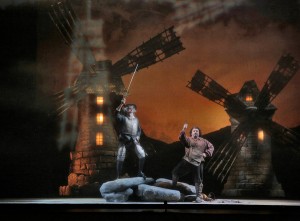 Despite a balanced budget, SDO’s board of directors voted on March 19, 2014 to cease operations following the final performance of Don Quixote on April 13. In response to the public uproar provoked by this announcement, the board voted on March 31 to delay closure until April 29 in order to consider other options. On opening night, it was evident that much of the public anger was focused on SDO CEO Ian Campbell. When he took to the stage preceding the performance, mayhem ensued. Campbell was booed, heckled and shouted at. Struggling to maintain his dignity, Campbell defiantly remained on stage until he had finished rendering thanks to all those who had contributed to the company’s success over the years.
Despite a balanced budget, SDO’s board of directors voted on March 19, 2014 to cease operations following the final performance of Don Quixote on April 13. In response to the public uproar provoked by this announcement, the board voted on March 31 to delay closure until April 29 in order to consider other options. On opening night, it was evident that much of the public anger was focused on SDO CEO Ian Campbell. When he took to the stage preceding the performance, mayhem ensued. Campbell was booed, heckled and shouted at. Struggling to maintain his dignity, Campbell defiantly remained on stage until he had finished rendering thanks to all those who had contributed to the company’s success over the years.
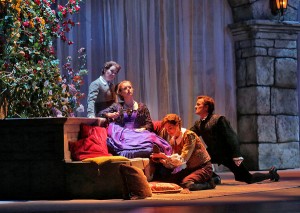 The five-act Don Quixote (1910), one of Jules Massenet’s last operas, focuses on the titular character, his sidekick Sancho Panza, and his love interest Dulcinea. The plot of the story is driven by Quixote’s quest to find Dulcinea’s stolen necklace. In the process, he tilts at windmills, gets kidnapped by robbers, and recovers her string of pearls. When Don Quixote returns the necklace to Dulcinea and asks for her hand in marriage, she spurns him. As he lies dying of a broken heart, Don Quixote bequeaths an island to his faithful Sancho.
The five-act Don Quixote (1910), one of Jules Massenet’s last operas, focuses on the titular character, his sidekick Sancho Panza, and his love interest Dulcinea. The plot of the story is driven by Quixote’s quest to find Dulcinea’s stolen necklace. In the process, he tilts at windmills, gets kidnapped by robbers, and recovers her string of pearls. When Don Quixote returns the necklace to Dulcinea and asks for her hand in marriage, she spurns him. As he lies dying of a broken heart, Don Quixote bequeaths an island to his faithful Sancho.
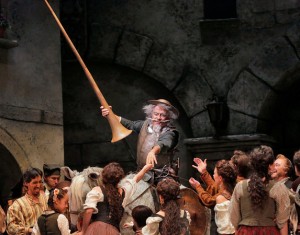 French librettist Henri Caïn wrote an incredibly moving story with excellent characterization. Sancho’s relationship to his master, for example, changes considerably from beginning to end. At the outset, Sancho makes fun of Quixote and acts as though he is babysitting a child. The turning point comes in Act III, when his master successfully faces the band of robbers and retrieves the necklace. In that scene, Don Quixote is revealed to be a Christ-figure after he is tied to a tree and left to die. As the knight-errant prays, the harmonic character of the music shifts, taking on a church-like tonality. In a startling transformation, the robbers kneel before Don Quixote and beseech his blessing upon them. Following this incident, Sancho treats Don Quixote with newfound respect and lovingly comforts the knight-errant on his deathbed.
French librettist Henri Caïn wrote an incredibly moving story with excellent characterization. Sancho’s relationship to his master, for example, changes considerably from beginning to end. At the outset, Sancho makes fun of Quixote and acts as though he is babysitting a child. The turning point comes in Act III, when his master successfully faces the band of robbers and retrieves the necklace. In that scene, Don Quixote is revealed to be a Christ-figure after he is tied to a tree and left to die. As the knight-errant prays, the harmonic character of the music shifts, taking on a church-like tonality. In a startling transformation, the robbers kneel before Don Quixote and beseech his blessing upon them. Following this incident, Sancho treats Don Quixote with newfound respect and lovingly comforts the knight-errant on his deathbed.
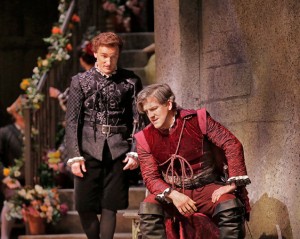 Acclaimed Italian bass Ferruccio Furlanetto, who has performed a variety of roles at SDO beginning in 1985, played Don Quixote in 2009 and reprises his role here. Furlanetto’s mastery of the role is evident from start to finish. Not only does he have the right physique (tall and thin) and age, but the strength, sonority, and authority of his voice are utterly captivating. It is also worth underscoring the emotional depth, poignancy, and sympathy of the master / minion or leader / follower relationship that Furlanetto and Argentinean bass-baritone Eduardo Chama as Sancho Panza share. That relationship contains a dynamism that provokes laughter as well as tears. It stands in stark contrast to the distance between Dulcinea (German mezzo-soprano Anke Vondung) and Don Quixote – a distance that is strengthened by the age gap between the two performers.
Acclaimed Italian bass Ferruccio Furlanetto, who has performed a variety of roles at SDO beginning in 1985, played Don Quixote in 2009 and reprises his role here. Furlanetto’s mastery of the role is evident from start to finish. Not only does he have the right physique (tall and thin) and age, but the strength, sonority, and authority of his voice are utterly captivating. It is also worth underscoring the emotional depth, poignancy, and sympathy of the master / minion or leader / follower relationship that Furlanetto and Argentinean bass-baritone Eduardo Chama as Sancho Panza share. That relationship contains a dynamism that provokes laughter as well as tears. It stands in stark contrast to the distance between Dulcinea (German mezzo-soprano Anke Vondung) and Don Quixote – a distance that is strengthened by the age gap between the two performers.
Dulcinea makes quite a stirring entrance. As the anticipation is built up by the singing and dancing of the villagers below her window, Vondung suddenly appears and volleys forth an exuberant cadenza showcasing her range and technical skill. Further vocal variety is provided by the casting of two cross-dressing sopranos 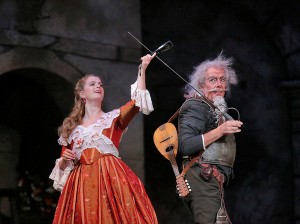 (Susannah Biller and Micaela Oeste) and two tenors (Simeon Esper and Joel Sorensen) as Dulcinea’s suitors. They provide some of the conflict and competition that spurs Don Quixote on his quest.
(Susannah Biller and Micaela Oeste) and two tenors (Simeon Esper and Joel Sorensen) as Dulcinea’s suitors. They provide some of the conflict and competition that spurs Don Quixote on his quest.
Scenic Designer Ralph Funicello opts for a realistic set design that anchors the story in reality, thereby preventing it from becoming a shallow farce. Set pieces tend to be village facades arranged around an open square or centrally-placed tree or rock formations that allow free and easy movement as well as unhampered viewing for all patrons. Lighting Designer Marie Barrett uses screens to good effect in Act II, keeping Funicello’s massive windmills mostly invisible until their climactic unveiling.
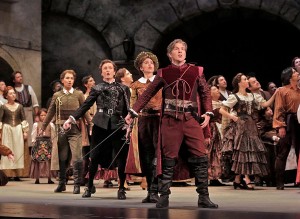 Costume Designer Missy West and Wig & Makeup Designer Steven W. Bryant further contribute to the production’s realism with an array of period gowns and coiffures. Although Don Quixote’s appearance is made to look ridiculous by the use of abundant hair-pieces that protrude in multiple directions, above all it serves to mark the knight-errant as someone whom the forward pace of society has left behind. He is a dinosaur and an anachronism. Kristina Cobarrubia’s flamenco dance choreography is also anachronistic, but it truly enlivens the village scenes.
Costume Designer Missy West and Wig & Makeup Designer Steven W. Bryant further contribute to the production’s realism with an array of period gowns and coiffures. Although Don Quixote’s appearance is made to look ridiculous by the use of abundant hair-pieces that protrude in multiple directions, above all it serves to mark the knight-errant as someone whom the forward pace of society has left behind. He is a dinosaur and an anachronism. Kristina Cobarrubia’s flamenco dance choreography is also anachronistic, but it truly enlivens the village scenes.
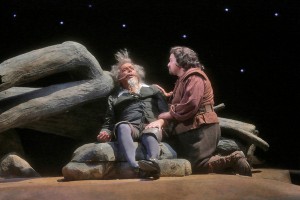 Don Quixote serves as a fitting final production for SDO when read as an allegory. In this interpretation, Don Quixote stands for opera in the present day. He is a noble character, albeit mocked, laughed at, and generally misunderstood. He has his moment of triumph, as when he succeeds in recovering Dulcinea’s necklace from the robbers, but ultimately the knight-errant fails to win the heart of his beloved. It is the humble Sancho that inherits Don Quixote’s mantle, so to speak. If SDO is to die like the anachronistic Don Quixote, all is not lost: perhaps opera’s future lies with Sancho in something simpler and more meaningful, not in the lavish superficiality of Dulcinea.
Don Quixote serves as a fitting final production for SDO when read as an allegory. In this interpretation, Don Quixote stands for opera in the present day. He is a noble character, albeit mocked, laughed at, and generally misunderstood. He has his moment of triumph, as when he succeeds in recovering Dulcinea’s necklace from the robbers, but ultimately the knight-errant fails to win the heart of his beloved. It is the humble Sancho that inherits Don Quixote’s mantle, so to speak. If SDO is to die like the anachronistic Don Quixote, all is not lost: perhaps opera’s future lies with Sancho in something simpler and more meaningful, not in the lavish superficiality of Dulcinea.
Don Quixote
San Diego Opera
San Diego Civic Theatre
1100 3rd Ave (Corner of Third Ave and B Street)
scheduled to end on April 13, 2014
for tickets, call (619) 533-7000
or visit www.SDopera.com
